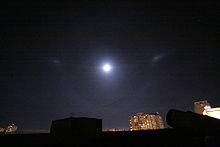Moon dog
Appearance

A moon dog, moondog, or mock moon,[1] (scientific name paraselene,[1] plural paraselenae, i.e. "beside the moon") is a relatively rare bright circular spot on a lunar halo caused by the refraction of moonlight by hexagonal-plate-shaped ice crystals in cirrus or cirrostratus clouds. Moondogs appear 22° to the left and right of the moon.[2] They are exactly analogous to sun dogs, but are rarer because to be produced the moon must be bright and therefore full or nearly full. Moondogs show little color to the unaided eye because their light is not bright enough to activate the cone cells of humans' eyes.
See also
References
- ^ a b "Definition of paraselene". Collins English Dictionary.
- ^ Lisle, Jason. The Stargazer's Guide to the Night Sky. p. 83.
